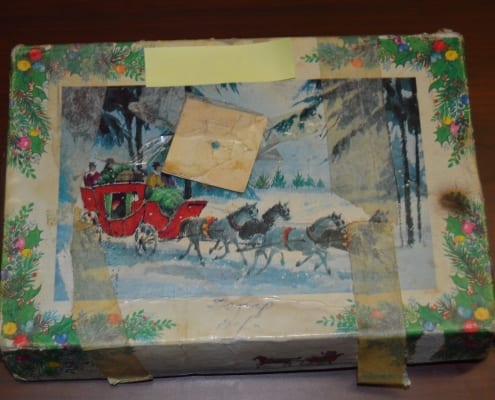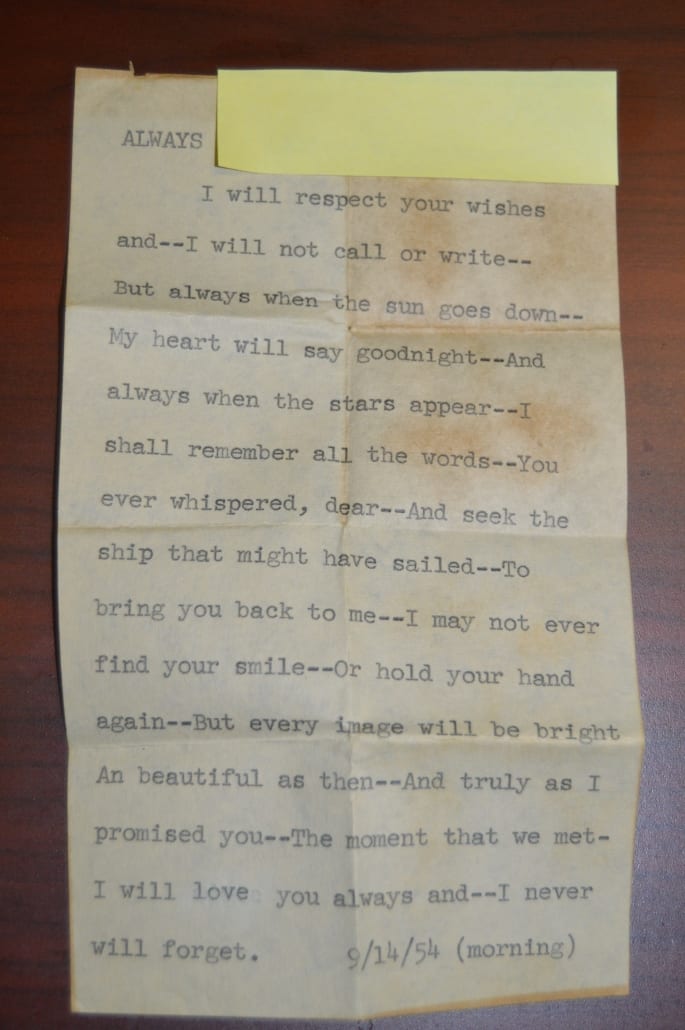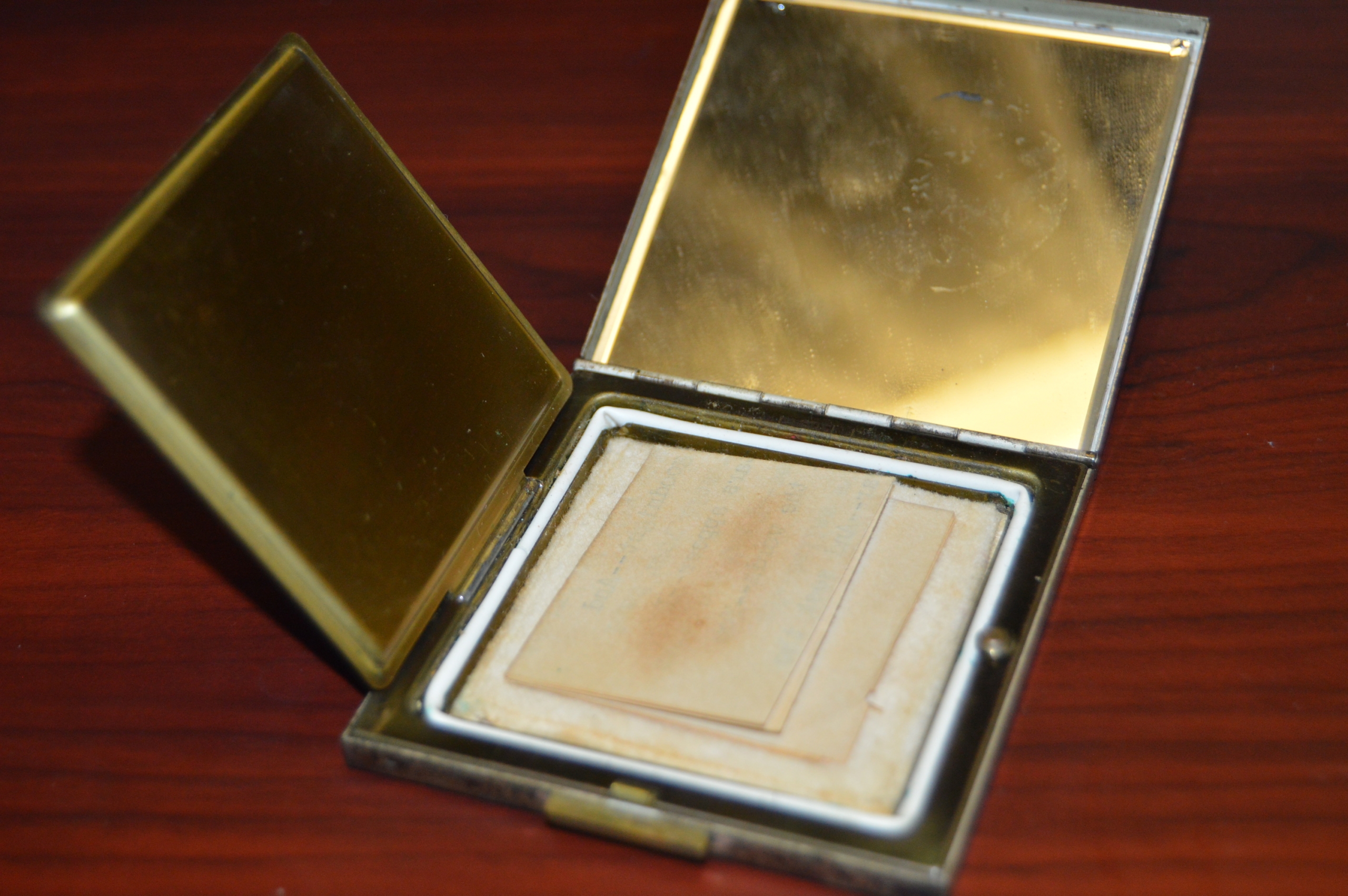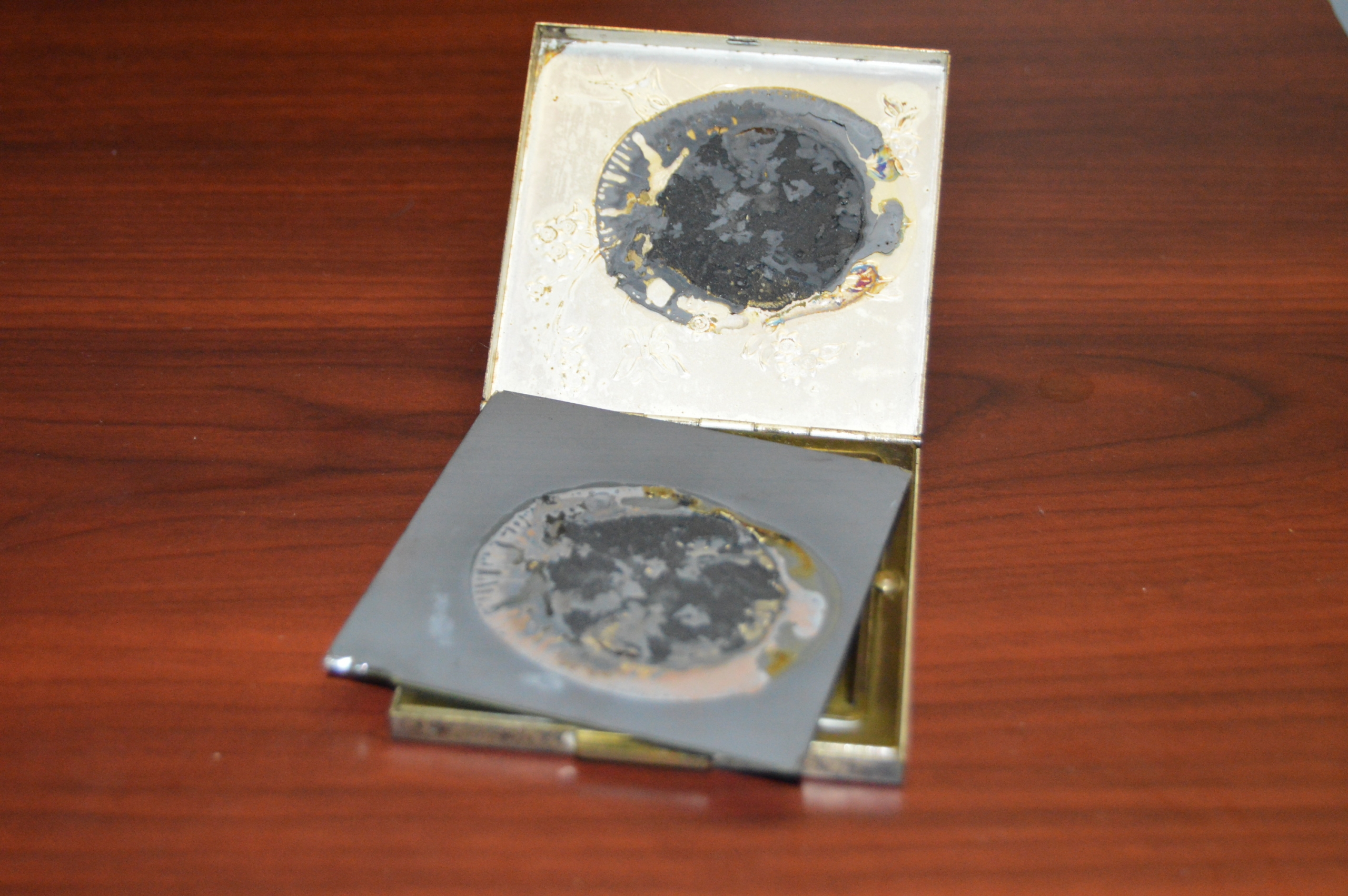The Rhetoric of Letter-Keeping

The Rhetoric of Letter-Keeping
Peitho Volume 22 Issue 3 Spring 2020
Author(s): Cheyenne Franklin
Cheyenne Franklin is a PhD student at Virginia Polytechnic Institute and State University where she studies and teaches rhetoric and writing. Her research interests include rhetorical style, Freshman Composition, and epistolary literature.
Tags: 22-3, archival research, epistolary rhetoric, Family Histories, Kin-Work, Letter Writing, recovery, women’s rhetoricWhen I was young, I could always count on a birthday card in the mail. This card was handmade, a sheet of printing paper folded and decorated with a penned sketch. Every year my brother who left when I was nine would send his apologies for his absence. I dreaded these birthday cards, storing them out of sight, but I kept them. These painful documents leave a question in my mind: Why do we keep painful writings? In an effort to answer this question, I sought cases of women who have acted as family archivists1 by keeping letters that document painful events. What I discovered is that women act rhetorically not only through letter writing but through letter keeping.
This study rhetorically analyzes two artifacts, a breakup note and a set of memorial letters. To analyze these items, I use imaginative reconstruction—a method feminist researchers such as Jacqueline Jones Royster and Zosha Stuckey use to conjecture multiple, most-likely narratives for incomplete histories—to assemble possible narratives for the artifacts. To support my analysis, I draw from epistolary and women’s rhetoric. This combination of scholarship sheds light on women’s rhetorical work guarding, editing, and facilitating family histories through their practices and methods of keeping letters. I conclude with a call for researchers to search garage/estate sales as uncommon archives where lost voices can be rediscovered.
In a 1987 article, Micaela di Leonardo identifies a sphere of women’s work called kin-work, community-building activities including phone calls, social visits, and letter writing (442). Although men occasionally participate in letter writing, historical research has revealed the way women specifically have used the genre as a rare space for feminine rhetoric. Because letter writing was often a part of family and household affairs, society preceding the Women’s Rights movement accepted women’s participation in the practice (Johnson). Lucille Schultz reveals the rhetorical importance of the practice when she notes that letter-writing instruction in the U.S. informed nineteenth-century virtues (118). Women, therefore, learned to use this domestic genre to comment on social justice (Buchanan), religion (Hoermann), and politics (Wallace; Sowards; Martin and Patrowski). Pamela VanHaitsma details a poignant example of such rhetoric in her article “Queering the Language of the Heart: Romantic Letters, Genre Instruction, and Rhetorical Practice.” VanHaitsma analyzes two twentieth-century African American women who reinvented letter-writing practices to accommodate their queer relationship. These women challenged letter-writing tradition which taught that letters should be either for business alone or romance with the intention of marriage. These revolutionary women, however, mixed the romantic with the professional, also nurturing a romantic relationship that in their time could never resolve in marriage. With epistolary writing, women adorned the guise of conservativeness, but they also found an available means by which they coped with and influenced society.
Discourse studies such as VanHaitsma’s show the incredible rhetoric behind women’s letter writing, but research has overlooked a second rhetorical act that women often participate in when handling letters: letter keeping. As the following case studies demonstrate, women enact an additional set of kin-work through letter keeping. By keeping letters, women document ancestors’ successes, guard family secrets, and connect community members.
I uncovered both of the following collections at separate estate sales, inside unexpected containers: the breakup letter in a makeup compact and the box of memorial letters inside a trunk. Unlike brick and mortar archives, which typically store artifacts in standard boxes and files, private archives often house items in meaningful containers. In many stories2 of discovered documents, the containers themselves play a critical and, I suggest, rhetorical role. Therefore, the following analyses consider the rhetoric of both the keeping of letters as well as the materials involved in that keeping.
The first collection includes a series of letters written by a mother to her deceased son, Ronny.3 This mother collected her letters in a holiday greeting card box (see Fig. 1, below) stored in a trunk. This archive consists of twelve letters, seven photographs, fifteen personalized newspaper clippings, and two short religious writings (a tract and a newspaper cutting). This pairing of items, as well as the box’s storage, says something about the purpose of the mother’s letter keeping. Like an undertaker who meticulously arranges a corpse, this mother carefully constructed her son’s memorial, using items that depict her favorite version of him: stories of him as a boy (told in her letters), a photograph of the granddaughter who resembles her father, and pieces of the faith the mother is certain her son also shared (Dec. 7, 1984, Letter). Additionally, the location where the mother stored the memorial is telling. Instead of choosing a location where she could daily view the memorial, the mother chose to hide it in a closed trunk. I imagine that, like her choice of materials, the choice of where to store the box was due to the mother’s desire to control the memory of her son. She kept her favorite parts of him for her own private viewing when she felt capable of fully engaging with her suffering. This collection represents a safe and contained place where she could give in to her pain. She could uncover the box, gaze upon the contents, and add another reflective letter as she attempted to find closure. The methods by which this mother kept her memorial letters shows minimal, yet incredible control. She could not undo the pain of her son’s death, but she could control how and when she remembered him. By creating and keeping this memorial, the mother enacted kin-work, keeping herself connected to her son.

Fig. 1. Box of memorial letters.
In addition to her own memory, the mother also used letters as an attempt to control her son’s public memory. Overwhelmingly apparent in all the mother’s letters is her work to keep her son connected to family. In one of the earliest letters, written only four months after Ronny’s death, his mother spends a quarter of the letter listing for Ronny the names of those who attended his funeral, who still speak of him, and who have taken his death the hardest. The woman also used the letters to update her son on what his daughter, wife, and other loved ones did each year. She describes holidays, moves, purchases, and illnesses and includes direct quotes from his daughter who had only just turned two when he died. In addition to these letters which she kept private, the mother kept certain letters publicly in a newspaper. Here she published notes that assured her son that he was missed on Easter, Valentine’s Day, Christmas, his birthday, and the anniversary of his death. Each of these announcements appears in the form of a letter, addressed to her deceased son. Unlike her handwritten letters, she chose to print these notes in the newspaper. This act indicates that even though the notes were addressed to Ronny, the woman intended them for a wider audience. It is likely that in this act, the woman was again performing a complicated attempt at kin-work by reminding her community to remember her son. Each note ends by assuring Ronny that his family will never forget him. Publicly printed, this closing would also remind others that they too should remember him.
Analyzing the breakup note (see Fig. 2, below) in the compact requires speculation since the letter offers few clues about its surrounding circumstances. In the top-left corner of the note is a man’s name. I have changed the name and concealed it in the photo to retain anonymity, but the real last name is popular in romance-language populations. Since this is the only name present and it does not appear in the left corner where we would expect the name of the recipient, I assume this is the author’s signature.

Fig. 2. Breakup Note.
Based on these sparse clues, we can infer that the author of the note likely had Spanish or French ancestry but wrote in fluent English. The man was clearly a romantic, given that he chose to deliver his goodbye in the form of a poem and must have held a great deal of affection for the recipient. None of this tells us anything about the woman who kept the note, though. All we can glean from the note about her is that, for some reason, she requested that the couple end communication. From this request, we can deduce that calls and written communication had been the norm for the couple. The reasonable conclusion from these details is that the two were romantically involved and that the note marked the end of the relationship. To better understand the woman who kept the note, we again have to depend on the discourse expressed in the rhetoric of her keeping the note and the material way she went about this keeping.
When it comes to the materials involved in this collection, the most overtly meaningful is the compact that houses the note. I found the note folded and tucked inside a latched compartment inside the compact (see Fig. 3, below). This compartment would have originally held a blotting cloth, now replaced with the note. In the fifties when the note was written, a woman would have kept a compact among her most personal items, likely stored in a vanity or purse, perhaps the only safe spaces where her husband and children would not prowl. This choice suggests two possible scenarios: the woman kept the note close as either a frequent reminder or to guard it from prying eyes. In the first scenario, one possible explanation for her wanting to keep the note as a reminder is that she was punishing herself for a choice she regretted. A more optimistic explanation is that the note offered her comfort because it provided her a gateway into a time when she was admired. In preserving the note, she also preserved this admiration, regardless of who she later became. Whatever her reason for keeping the note, the act ensured that she would reserve a closeness to this admirer. In the second scenario, the letter is not just close but hidden. Typically, secrecy is kept for one of two reasons. The possessor of the secret fears either the shame of the secret or the anger that could result from another’s knowledge of the secret. If the woman married, or was married to, another man, she likely would have kept the note hidden to keep her family intact. Therefore, the woman did not initiate kin-work by writing the note, but she did continue kin-work in the way she kept the note. Keeping the note preserved a bond between her and her admirer. Keeping the note hidden possibly preserved the family she built after the relationship.

Fig. 3. Latched compartment open on compact.
The memorial letters demonstrate how significant paired items can be for kept letters. The same is true of the breakup note. Although the breakup note is alone in its latched compartment, the main compartment holds a broken mirror, detached from the lid so that it flops and clatters when the compact is opened (see Figure 4, below). We cannot know how long the mirror has been broken, but the image recalls for me a line from the 1960 film The Apartment when Fran Kubelik tells “Bud” Baxter that she carries a broken mirror because “it makes me look the way I feel.” Perhaps our mystery woman carried the breakup note alongside the detached mirror because she also felt detached and consequentially broken. The note represents an attempt to remain close to a time or person that made her feel loved, but the attempt is flawed just as the note’s container is also flawed.

Fig. 4. Detached mirror from compact.
Based on these case studies, I suspect that we have underestimated the rhetorical role women play in keeping written artifacts. Letter writing is just the beginning of women’s kin-work and rhetorical means. When they keep letters, they continue their work for the family by guarding the secrets, memorializing the events, and bridging the gaps between distant or deceased relatives. The mother used private and public letters to stave off emotional detachment from her son. The breakup note bound the woman to her admirer, despite physical and relational distance. In preserving and protecting such letters, women preserve and protect their loved ones, continuing the kin-work initiated in the original act of writing the letters.
Kin-work offers a new lens through which we can study women’s rhetoric, which does not always fit conveniently into traditional rhetoric. Future discussions might consider what rhetoric emerges when women’s acts/materials are re-read through this lens. Furthermore, a rich discussion could be had concerning the ethics of “reading” such sensitive and often secret materials. What, for instance, happens to a deceased author’s rights when a family sells her private writings? Can we justify the publicizing of these writings for the sake of continuing the community kin-work started by an author’s initial authorship? Archival research can specifically gain from these case studies. Carol Mattingly and Barbara Biesecker argue that women’s rhetoric should highlight new styles of rhetoric that diverge from the classical, machismo styles from which women were largely excluded. If we are to reap knowledge from women who lack positions of public power, we have to look to uncommon archives for quieter, domestic writings. Garage/estate sales can be prime archives where we can discover such writings. As was the case with the artifacts studied here, women’s rhetorical letters can surface at sales when benefactors edit their inherited collections. By meeting these inheritors halfway, researchers of rhetorical and archival materials can tap into lost remnants of woman’s rhetoric and kin-work.
Endnotes
- For this study, I use Rawson’s expanded definition of archives as used in “The Rhetorical Power of Archival Description: Classifying Images of Gender Transgression,” which includes any aged documents of historical value even if they have not been formally arranged by an institution (329).
- See for instance Jason Whitely’s “Hidden Letters Discovered in Old Desk Reveal Tragic Story of WWII You Haven’t Heard.”
- I have changed the name and concealed it in the photo to retain anonymity.
Works Cited
- Biesecker, Barbara. “Coming to Terms with Recent Attempts to Write Women into the History of Rhetoric.” Philosophy and Rhetoric, vol. 25, no. 2, 1992, pp. 140-161.
- “Breakup Note.” 1954. MS. Personal Collection.
- Buchanan, Lindal. “Motherhood, Rhetoric, and Remembrance: Recovering Diane Nash.” Peitho, vol. 15, no. 2, 2013, pp. 14-39.
- di Leonardo, Micaela. “The Female World of Cards and Holidays: Women, Families, and the Work of Kinship.” Signs, vol. 12, no. 3, Spring 1987, pp. 440-453.
- Hoermann, Jackie. “Speaking Without Words: Silence and Epistolary Rhetoric of Catholic Women Educators on the Antebellum Frontier, 1828-1834.” Young Scholars in Writing: Undergraduate Research in Writing and Rhetoric, vol. 9, Spr. 2012, pp. 19-30.
- Johnson, Nan. “‘Dear Millie’: Letter Writing and Gender in Postbellum America.” Gender and Rhetorical Space in American Life, 1866-1910. Southern Illinois UP, 2002.
- Martin, Andrea and Tyyne Petrowski. ” ‘Are You “Doing Your Bit?’: Edith Robertson, Letter-Writing, and Women’s Contributions in First-World-War Winnipeg.” Manitoba History, no. 82, 2016, pp. 4-12.
- Mattingly, Carol. “Telling Evidence: Rethinking What Counts in Rhetoric.” Rhetoric Society Quarterly, vol. 32, no. 1, 2002, pp. 99-108.
- “Memorial Letters.” 1983-1989. MS. Personal Collection.
- Rawson, K.J. “The Rhetorical Power of Archival Description: Classifying Images of Gender Transgression.” Rhetoric Society Quarterly, vol. 48, no. 4, 2018, pp. 327-351.
- Royster, Jacqueline J. Traces of a Stream: Literacy and Social Change Among African American Women. U of Pittsburgh P, 2000.
- Schultz, M. Lucille. “Letter-Writing Instruction in 19th Century Schools in the United States.” Letter Writing as a Social Practice, edited by David Barton and Nigel Hall, John Benjamins Publishing, 2000.
- Stuckey, Zosha. “‘What has become of Jimmy Thornton?’: The Rhetoric(s) of Letter-Writing at The New York State Asylum for Idiots, 1855-1866.” Disability Studies Quarterly, vol. 31, no. 3, 2011, p. 11.
- The Apartment. Directed by Billy Wilder, performances by Jack Lemmon, Shirley Maclaine, Fred MacMurray, Jack Kruschen, Adolph Deutch, Joseph LaShelle, and Daniel Mandell, The Mirisch Company, 1960.
- VanHaitsma, Pamela. “Queering the Language of the Heart: Romantic Letters, Genre Instruction, and Rhetorical Practice.” Rhetoric Society Quarterly, vol. 44, no. 1, 2014, pp. 6-24.
- Wallace, Patricia D. “Feminine Rhetoric and the Epistolary Tradition: The Boniface Correspondence.” Peitho, vol. 24, no. 3, 1995, pp. 229-246.
- Whitely, Jason. “Hidden Letters Discovered in Old Desk Reveal Tragic Story of WWII You Haven’t Heard.” WFAA, 23 July 2019. Accessed 23 Dec. 2019.